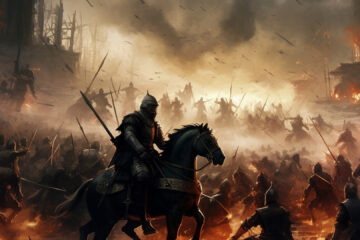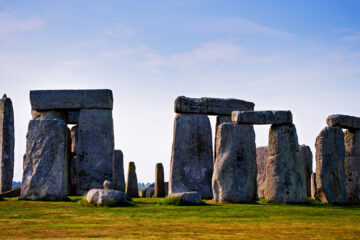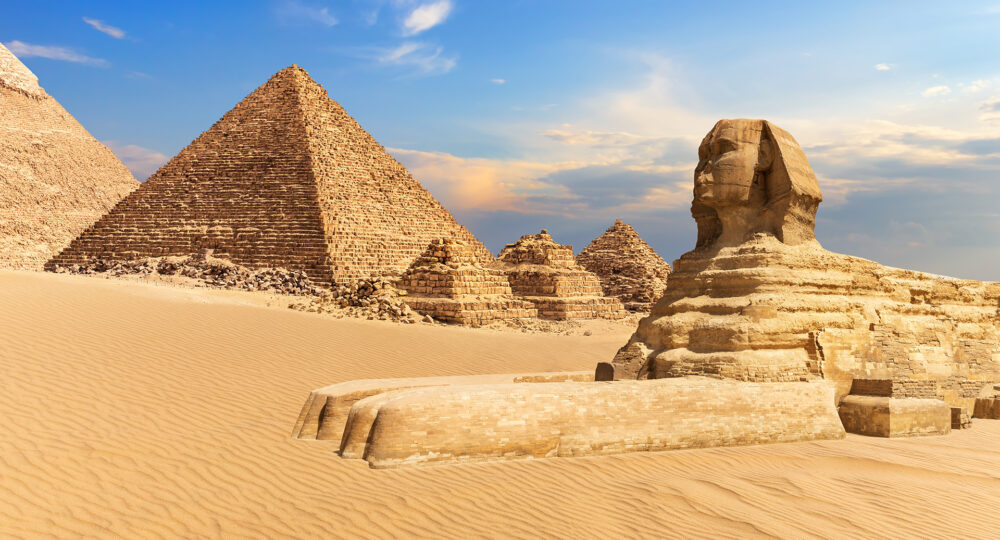
Behind the Pyramids: Everyday Life of Royals, Nobles and Commons in Ancient Egypt
In the heart of the ancient world, along the fertile banks of the Nile, the daily life of ancient Egyptians thrived with a vibrancy that has captivated historians for centuries. From the pharaohs’ grandeur to farmers’ diligent routines, this civilisation harnessed the river’s bounty, crafting a society rich in tradition and innovation. Each day, as the sun rose over the pyramids, a tapestry of activities unfolded – artisans honed their crafts, priests performed sacred rituals, and merchants bustled in lively marketplaces. In this writing, we are rewinding time to explore the nuances of everyday life in ancient Egypt, unveiling a world where religion, culture, and nature intertwine seamlessly in the Nile’s rhythm.
Gods, Temples and Spiritual Dimensions

An illustration of an ancient Egyptian priest performing rituals to the Goddess Isis in the temple premises.
In the golden sands of ancient Egypt, a world rich with spiritual complexity and divine intricacy unfolded. The Egyptians are renowned for their monumental pyramids, the pantheon of gods, the grandeur of temples, and the spiritual beliefs that shaped one of history’s most fascinating civilisations.
The Pantheon of Gods: A Celestial Hierarchy
At the core of Egyptian spirituality lay a diverse and extensive pantheon of gods, each embodying aspects of natural and societal elements. Major deities like Ra, the sun god, and Osiris, the god of the afterlife, dominated the celestial hierarchy. The goddess Isis, revered for her magical prowess and motherly protection, and Horus, the falcon-headed god, symbolising kingship and power, were central to Egyptian worship. These gods were not mere mythical figures but integral to the Egyptians’ understanding of the world’s functioning, from the Nile’s flooding to the sun’s daily journey across the sky.
Temples: The Abodes of the Gods
Temples in ancient Egypt were not just places of worship; they were considered the literal houses of gods. These structures, ranging from colossal stone edifices to smaller, more intimate shrines, were the epicentres of religious activity. The temple of Karnak, a vast complex dedicated to the Theban triad of Amun, Mut, and Khonsu, exemplifies these sacred spaces’ architectural splendour and spiritual significance. Inside these temples, priests performed daily rituals, offering food, clothing, and prayers to the gods, ensuring the maintenance of ma’at, or cosmic order, a fundamental concept in Egyptian theology.
Spiritual Beliefs: Life, Death, and the Afterlife
The spiritual dimensions of ancient Egypt extended beyond the physical world into the realms of death and the afterlife. Egyptians held a profound belief in the afterlife, a reflection of which is evident in their meticulous mummification processes and tomb constructions. The Egyptian Book of the Dead, a collection of spells and instructions, guided the deceased through the perilous journey to the afterlife. The concepts of ka (spiritual essence) and ba (personality) were central to their understanding of human existence, transcending death and continuing in the afterlife.
The Legacy of Egyptian Spirituality
The spiritual world of ancient Egypt, with its gods, temples, and beliefs about the afterlife, was not merely a religious framework; it was the backbone of their civilisation. This intricate belief system influenced every aspect of Egyptian life, from art and architecture to social and political structures. Today, the remnants of their temples and the stories of their gods continue to fascinate and inspire, offering a window into the minds and hearts of this extraordinary ancient culture.
Ancient Egypt offers a vivid divine interaction and religious expression. The gods and goddesses, the majestic temples, and the deeply-rooted beliefs in the afterlife collectively paint a picture of a civilisation deeply connected to the divine, etching its legacy in the annals of human history.
Royal Routines and Common Customs
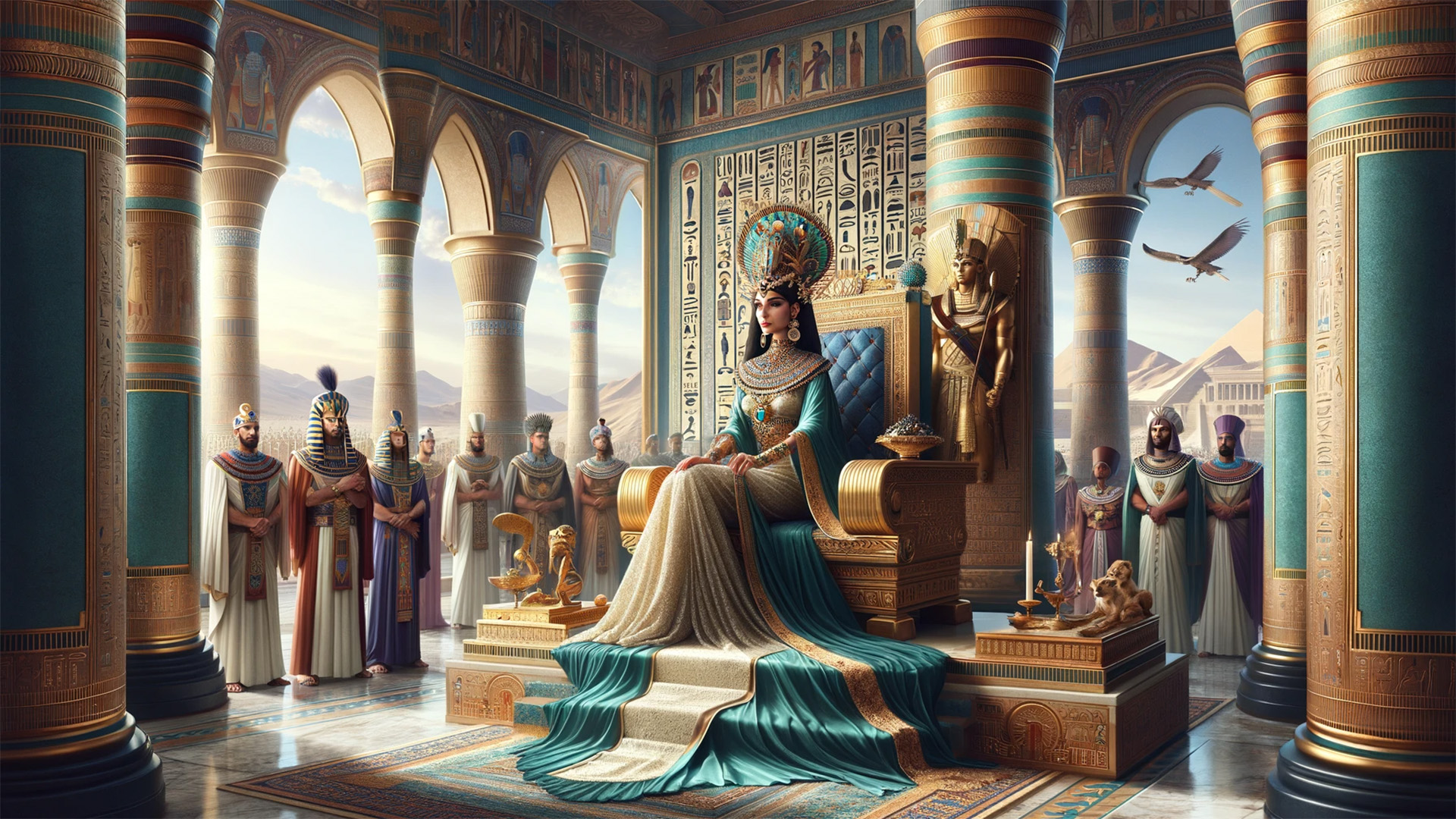
An illustration of the queen of ancient Egypt with nobles and priests in her royal court.
In the storied realm of ancient Egypt, the division between royal routines and common customs reflected the hierarchical nature of its society. Yet, both were deeply entrenched in tradition and ritual. Pharaohs, viewed as divine rulers, led lives of opulence and ceremonial grandeur. Their days began with elaborate purification rituals, followed by offerings to the gods, ensuring their favour and the kingdom’s prosperity. Royal duties involved overseeing the administration of vast lands, dispensing justice, and leading military campaigns. These rulers, adorned in fine linen and exquisite jewellery, epitomised ancient Egyptian power and religious authority. They were often depicted in grandiose temple reliefs engaging with gods or leading their people in triumph.
Contrastingly, the daily lives of common Egyptians, though less glamorous, were rich in cultural traditions and communal harmony. Farmers, labourers, and artisans, the backbone of Egyptian society, followed routines dictated by the cycles of the Nile and agricultural seasons. A typical day involved arduous work in fields or workshops but was also interspersed with communal activities and family time. Meals, often consisting of bread, beer, and onions, were family affairs, reflecting the society’s emphasis on kinship and community. Festivals and religious observances, open to all social strata, offered respite from daily toils, where commoners could partake in celebrations, feasting, and worshipping alongside nobility. Thus, in ancient Egypt, the rhythm of life, from the pharaoh’s palace to the humblest village, was a dance of duty, devotion, and communal ties underpinned by a deep reverence for the gods and the natural order.
Domestic Life, Slavery and Education
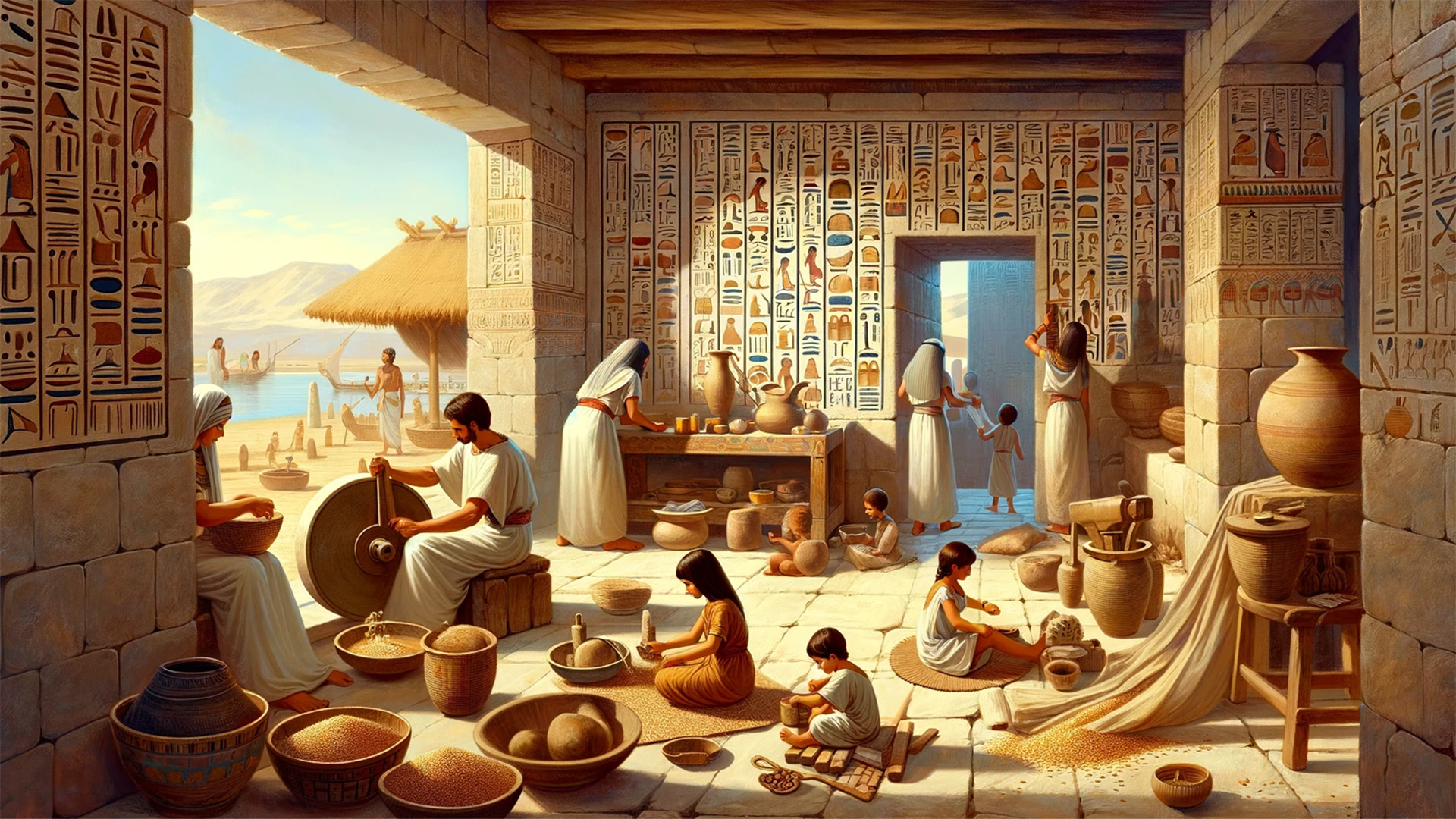
An illustration depicting the daily life in Ancient Egypt.
Within the sun-baked mudbrick walls of an ancient Egyptian household, domestic life unfolded in a rhythm dictated by simplicity and necessity. The family unit, central to Egyptian society, operated under a well-defined structure, with each member playing a specific role. Men, typically the breadwinners, engaged in farming, craftsmanship, or administrative tasks, depending on their social status. Women, revered as homemakers, skillfully managed the household, preparing meals from staples like bread and beer, weaving clothing, and caring for children. Though predominantly domestic, their roles were highly respected; women could own property, initiate divorce, and were often involved in family businesses. Homes, simple in design, centred around a common living area, where daily activities and family interactions took place, creating a warm, communal atmosphere.
The concept of slavery in ancient Egypt, while present, differed significantly from later historical practices, particularly those known in the modern era. Enslaved people in Egypt were primarily war captives or people indebted to the state, often serving in households, temples, or on royal projects like pyramids and tombs. Unlike the brutal chattel slavery seen in other ancient civilisations, enslaved Egyptians could own personal items, marry, and were sometimes allowed to earn their freedom. In many cases, their status more closely resembled that of serfs or servants rather than the harsh conditions typically associated with slavery.
It’s important to note that the workforce responsible for monumental constructions like the pyramids was not primarily made up of slaves. Recent archaeological findings suggest that these workers were actually skilled labourers, often participating in these grand projects as a form of tax payment to the state. They worked under reasonable conditions, received rations, and were buried with respect near the tombs they helped construct. This system reflects the ancient Egyptians’ complex societal structure, where labour and service were integral to both the economy and the religious-cultural ethos of the time, embodying a unique blend of obligation, duty, and communal participation.
Education in ancient Egypt was primarily a privilege of the elite, with formal learning reserved for boys who would enter administrative, religious, or scribal professions. These young learners were instructed in reading, writing, mathematics, and various sciences essential for their societal roles. However, for most children, education was informal, learning practical skills and trades from their parents, which fostered a strong sense of continuity and tradition. Girls were taught by their mothers, mastering the art of homemaking, which included cooking, weaving, and managing household affairs. Despite these gender-specific roles, Egyptian society offered a relatively progressive view on women and education, recognising their ability to learn and participate in cultural and economic activities. This familial and educational structure, deeply rooted in practicality and tradition, shaped the social fabric of ancient Egyptian life, creating a community bound by shared values and collective wisdom.
Trade and Commerce in Ancient Egypt
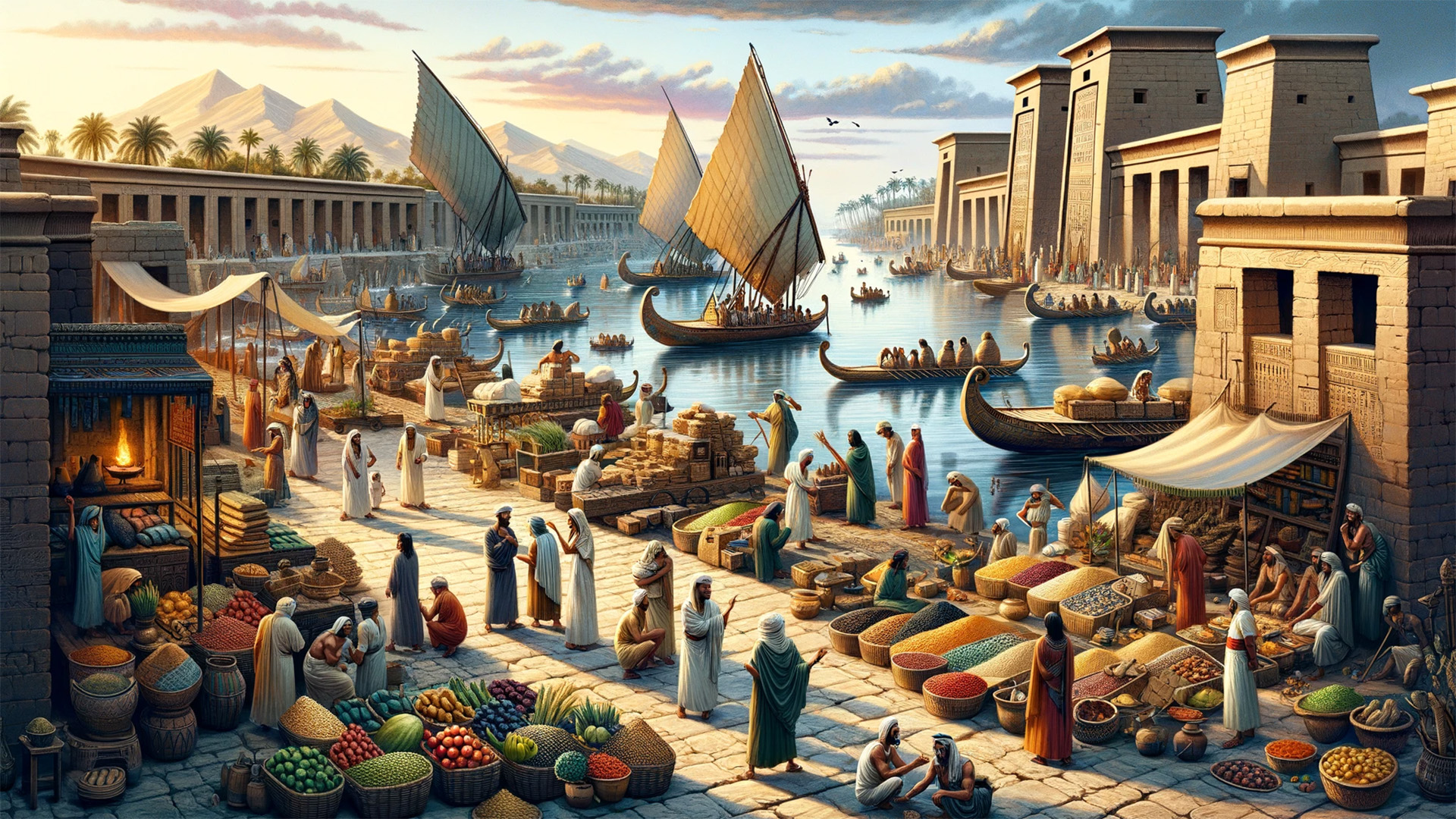
An illustration of trade activities at a marketplace in ancient Egypt.
The economic vitality of ancient Egypt, a civilisation known for its architectural wonders and intricate art, was significantly bolstered by its robust trade and commerce systems.
The Role of the River Nile in Egyptian Trade
Central to the economic success of ancient Egypt was the Nile River, a natural highway that facilitated the movement of goods and people. The predictable flooding of the Nile not only made the land fertile for agriculture but also provided a means for transporting goods across different regions. Egyptians built boats and ships to navigate the Nile and the open sea, allowing trade with distant lands. This ease of transportation enabled the exchange of commodities like grain, papyrus, and linen from within and the acquisition of luxury items from abroad.
Domestic Trade and Marketplaces
Within Egypt, local trade thrived in marketplaces where people bartered goods and services. Artisans, craftsmen, and farmers brought products to these markets, exchanging them for other necessities. While lacking a standardised currency, this barter system was efficient and widespread, underpinned by the value of commodities like grain or beer. The pharaoh’s role in regulating and overseeing this internal trade was pivotal, ensuring resources were distributed adequately, especially during times of scarcity.
International Trade and Diplomatic Relations
Beyond its borders, ancient Egypt engaged in international trade with neighbouring regions like Nubia, the Levant, and the Mediterranean. These trade relations were often intertwined with diplomatic efforts, as evidenced by the famous Amarna letters, which depict correspondence between the Egyptian court and other powerful rulers of the time. Exotic goods such as gold, ebony, ivory, and incense flowed into Egypt, while Egyptian exports included fine linen, papyrus, and grain. Such exchanges enriched the Egyptian economy and fostered cultural and technological exchanges.
Impact on Society and Culture
The effects of trade and commerce in ancient Egypt extended beyond economic prosperity. They significantly shaped the social hierarchy, as merchants and traders gained prominence alongside traditional elite classes like priests and nobles. The influx of foreign goods and ideas contributed to the cultural richness of Egypt, influencing art, architecture, and even religious practices. Additionally, the economic stability of successful trade allowed for the funding of monumental construction projects, further solidifying Egypt’s legacy.
The Nile River’s contribution to facilitating trade, coupled with Egypt’s strategic geographic location, positioned it as a pivotal trade hub in the ancient world. The resulting economic stability not only ensured the sustenance of its people but also allowed for the flourishing of a culture that continues to fascinate the modern world. The legacy of ancient Egyptian trade is a testament to the ingenuity and adaptability of this remarkable civilisation.
The daily life in ancient Egypt presents a rich diversity and ingenuity, a testament to the resilience and creativity of its people. From the majestic rituals of the pharaohs to the harmonious routines of the commoners, each aspect of life along the Nile was imbued with a sense of purpose and community. The Egyptians’ profound connection with their land, gods, and each other forged a civilisation that, through its art, architecture, and enduring cultural practices, continues to captivate and enlighten us thousands of years later. This ancient society, balanced delicately between the grandeur of its rulers and the steadfastness of its people, offers a timeless window into the complexities and triumphs of human civilisation.
References:
- Daily Life of the Ancient Egyptians by Bob Brier and Hoyt Hobbs – provide an engaging look into the everyday lives of ancient Egyptians, from pharaohs to peasants. The book covers aspects such as family life, leisure activities, food, clothing, and religion, offering a vivid picture of day-to-day existence in ancient Egypt.
- The Complete Gods and Goddesses of Ancient Egypt by Richard H. Wilkinson – an essential resource for understanding the complex pantheon of Egyptian deities and their significance in daily life. It explores the roles and representations of the gods and how they influenced the daily religious practices of the Egyptians.
- The Nile: Travelling Downriver Through Egypt’s Past and Present by Toby Wilkinson – the author’s narrative combines historical information with travelogue, emphasizing the Nile’s centrality to Egyptian life and culture. It provides insights into how the river influenced daily activities and shaped the civilization’s development.


